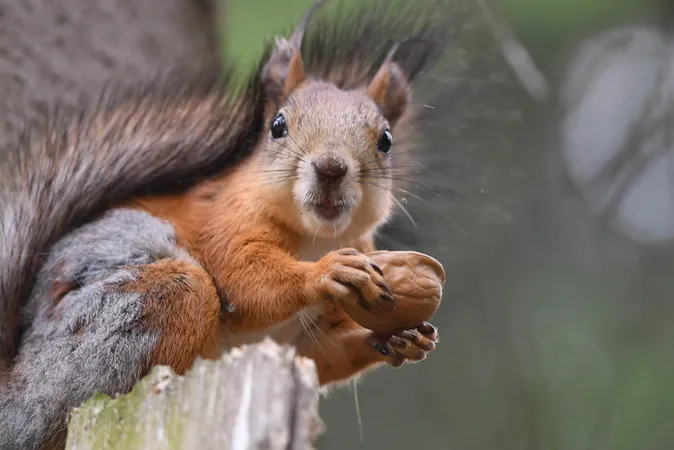
Why Nature's Intelligence Outshines Artificial Intelligence: Lessons from Fruit Flies, Bees, and Squirrels
2025-03-23
Author: Wei Ling
Introduction
In a recent announcement, OpenAI CEO Sam Altman expressed optimism about the creation of artificial general intelligence (AGI) — machines possessing human-like intelligence. Speaking to Bloomberg, he suggested that simply enhancing existing models, like ChatGPT, could lead us to this ambitious goal. “AGI will probably get developed during [Trump’s] term,” he ventured, echoing the narrative OpenAI has pushed since the stunning introduction of ChatGPT in November 2022.
However, an OpenAI blog post from 2023 posits that “the first AGI will be just a point along the continuum of intelligence,” which sounds promising but rests on a crucial oversight: intelligence may not exist on a straightforward continuum at all.
Altman and others deeply embedded in the tech landscape approach AI's trajectory with a specific expectation. They presume an understanding of our pathway towards human-like intelligence, disregarding the complexities surrounding the term "intelligence" itself, which remains largely undefined. Psychological insights touch upon concepts like "fluid g," a flexible problem-solving ability, but the scientific community still grapples with a clear interpretation of what intelligence truly entails.
If an alien entity observed Earth's intelligence landscape, it might be bewildered to find that while AI research is booming, it occurs amidst vague definitions of intelligence. A broader examination of the animal kingdom would pose even more perplexities, revealing that natural intelligence varies greatly among species.
Ecological Intelligence: A Closer Look at Nature
Natural intelligence encompasses a variety of creatures from fleas to elephants. When considering ecological intelligence — the ability to adapt and thrive in specific environments — the humble fruit fly emerges as a standout candidate, potentially outpacing even the most sophisticated artificial systems.
The Fruit Fly's Superior Navigation Skills
In the realm of autonomous navigation, AI systems often strive for the ability to maneuver through challenging environments using complex algorithms. Yet, fruit flies, with their minuscule brains, display astounding collision-avoidance capabilities, surpassing self-driving vehicles. They can detect rapid motions, predict movements, and execute swift evasive actions in milliseconds. Groundbreaking research reveals that these tiny insects calculate escape routes faster than advanced computer vision technologies.
If motion planning and decision-making equate to intelligence, fruit flies might just merit their own round of funding as the leading AGI contenders.
The Bees Exemplify Collective Intelligence
While AI enthusiasts dream of hive-mind intelligence through networking, nature has already provided an incredible example: bees. Honeybee colonies exhibit decentralized decision-making that rivals complex algorithmic strategies. During hive relocation, they employ intricate communications called "waggle dances" to convey relevant information about potential new sites. This impressive collective intelligence emerges from thousands of straightforward interactions, challenging the notion that AI's current capabilities can match such efficiency.
Squirrels: Masters of Memory Management
In data storage, AI systems are praised for their capacity to manage extensive datasets. Yet, the common squirrel demonstrates superior memory engineering. These animals not only hoard nuts but also accurately remember their locations even months later. Intriguingly, they employ deceptive behaviors to mislead competitors about their buried treasures. This innate ability to efficiently store and retrieve information starkly contrasts with AI’s tendency to "hallucinate" unrealistic scenarios, as it lacks a tangible connection to real-world experiences.
Redefining Artificial Intelligence
The comparison with the animal kingdom compels us to reevaluate what intelligence truly means. Intelligence is not a universal constant; rather, it manifests in unique ways shaped by evolutionary circumstances. Different creatures exemplify specialized strategies for survival — the swift decision-making of the fruit fly, the sophisticated social dynamics of bees, and the robust memory skills of squirrels all underscore various forms of intelligence.
Furthermore, the prevailing AI paradigm, rooted in scaling existing neural networks, assumes that sheer data and processing power will eventually emulate human-like intelligence. However, if natural intelligence operates on multiple spectra, it challenges the assumption that only one methodological approach — data-driven statistical learning — can navigate us towards AGI.
True intelligence is intricately entwined with embodiment and interaction within dynamic environments. In contrast, AI relies on abstraction, predicting textual sequences without grasping underlying relations or effects.
So, is AGI on the horizon? Possibly. Yet, if we are to draw insights from nature, investing in research to understand the intelligence of creatures like fruit flies may hold the key to unlocking the mysteries of our own technological aspirations.


 Brasil (PT)
Brasil (PT)
 Canada (EN)
Canada (EN)
 Chile (ES)
Chile (ES)
 Česko (CS)
Česko (CS)
 대한민국 (KO)
대한민국 (KO)
 España (ES)
España (ES)
 France (FR)
France (FR)
 Hong Kong (EN)
Hong Kong (EN)
 Italia (IT)
Italia (IT)
 日本 (JA)
日本 (JA)
 Magyarország (HU)
Magyarország (HU)
 Norge (NO)
Norge (NO)
 Polska (PL)
Polska (PL)
 Schweiz (DE)
Schweiz (DE)
 Singapore (EN)
Singapore (EN)
 Sverige (SV)
Sverige (SV)
 Suomi (FI)
Suomi (FI)
 Türkiye (TR)
Türkiye (TR)
 الإمارات العربية المتحدة (AR)
الإمارات العربية المتحدة (AR)